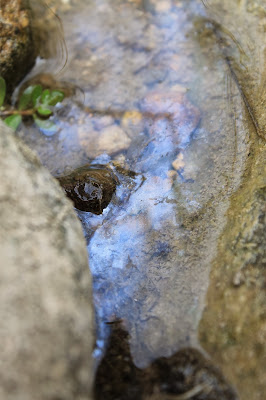On December 3, 2013 I found sign of beavers along the Creek. This was a first. Apparently, one or more beavers cut down several willows at the junction of the stream coming out of the Pond and the main body of the Creek. Then a four-and-a-half inch rain washed away the remains of the fallen trees. All that was left behind were the stumps and piles of large wood chips seen below (nutria will cut on trees but won't leave behind chips like these).
 |
| The view looking downstream from just about where the beaver cut the larger of the willow trees. These were the waters the beaver may have been trying to manage. |
 |
| Apparently an older cutting than the large ones above this image. |
 |
| The two larger cuttings can be seen in the middle just above the creek in this view looking north. |
 |
| And some nice fossils of what appear to be stems of plants. The fossils were in sandstone just downstream of the Pool and on the opposite bank among the huge boulders. |



















